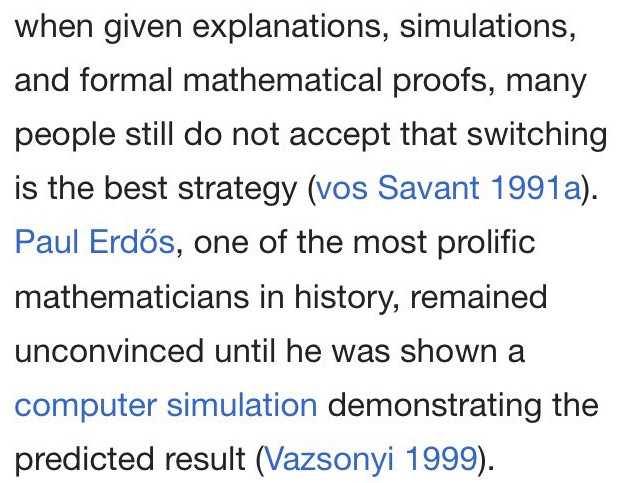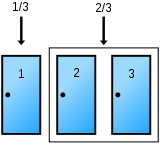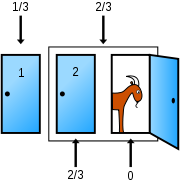The Monty Hall Problem is Very Counterintuitive
- If you still don’t believe it, you are in good company:


Simplest Explanation
- Your first choice has a 1/3 chance of having the car
- So there’s a 2/3 it is behind one of the other doors

- Monty will never open the door with the car behind it
- After he opens a door, the entire 2/3 probability shifts to the other closed door

Monty is Key!
Imagine you chose door 1, and you are asked whether you want the prize behind door 1 or the better of the prizes behind doors 2 and 3
This is exactly what you get when you switch (because Monty always removes the worse prize of the two when he opens a door)!
Another Appeal to Intuition
- Imagine there are 100 doors, 99 goats, and 1 car
- You pick a door, so you have a 1/100 chance of winning the car
- Then Monty opens 98 of the doors revealing 98 of the goats
There is still one other unopened door: Should you switch?
- If you pick a goat on your first choice (99/100), you will always get the car if you switch
By switching, you only get a goat if you had the car at first, and that’s super rare (1/100)
More Involved (and More Satisfying) Explanation
Consider the Following Scenario:
- Say you pick door 1 and then Monty opens door 3
Should you stay with door 1 or switch to door 2?
Before Monty opened door 3, the car had a \(1/3\) chance of being behind each door
\[ p(car1)=\frac 13,\ \ \ p(car2)= \frac 13, \ \ \ p(car3)=\frac 13 \]
But Monty is not opening doors at random: He will always open a goat door (and never the car)!
What is the probability Monty opens door 3, the true location of the car?
If you were right initially (the car is actually behind door 1), Monty can open either door 2 or door 3 (and picks one at random):
\[ p(open3 \mid car 1) = \frac 12 \\ \text{(in words: the probability Monty opens #3 given that the car is behind #1 is 1/2)} \]
- However, if you chose door 1 and the car is behind door 2, Monty has no choice but to open door 3!
\[ p(open3 \mid car2) = 1 \]
- Finally, if you chose door 1 and the car is behind door 3, Monty cannot open door three without revealing the car! This has no chance of happening.
\[ p(open3 \mid car3) = 0 \]
Bayes’ Rule
- OK, so you chose door 1 and then monty opened door 3
What are the chances that the car is behind door 2 (i.e., should you switch)?
- We are interested in \(p(car2 \mid open3)\)
From above, we already have the flip of it, but this is not the same: \(p(open3 \mid car2)\)
We can turn it around using Bayes’ rule, which states that
\[ p(A\mid B)=\frac{p(A)p(B\mid A)}{p(B)} \]
In our case,
\[ p(car2 \mid open3)=\frac{p(car2)p(open3 \mid car2)}{p(open3)} \]
- We already have the two pieces in the numerator (from above):
\[ p(car2 \mid open3)=\frac{(\frac 13 )\left(1\right)}{p(open3)} \]
- We just need the denominator (the probability Monty opens door 3)
- We can get this by adding together the probabilities of all the different situations in which Monty opens door 3 (this is the Law of Total Probability):
\[ \begin{aligned} p(open3)&=p(open3\ \& \ car1)+p(open3\ \& \ car2)+p(open3\ \& \ car3)\\ &=p(car1)p(open3 \mid car1)+p(car2)p(open3 \mid car2)+p(car3)p(open3 \mid car3)\\ &=(\frac13)(\frac 12)+(\frac13)(1)+(\frac13)(0)\\ &=(\frac16)+(\frac13)+(0)\\ &=\frac 12 \end{aligned} \]
- Now we have the denominator, so
\[ p(car2 \mid open3)=\frac{(\frac 13 )\left(1\right)}{(\frac12)}=2/3 \]
This tells us that, if we picked door 1 and Monty opened door 3, then there is a \(\frac23\) chance that the car is behind door 2
That means there is only a \(\frac13\) chance the car is behind door 1 (let’s use Bayes’ rule again)
\[ p(car1 \mid open3)=\frac{(\frac 13 )(\frac 12)}{(\frac12)}=1/3 \]
Thus, we would be much better off switching!
This will be true no matter which door you pick initially!
# The probability the car is behind door 1, door 2, and door 3 is initially 1/3
car1 <- 1/3
car2 <- 1/3
car3 <- 1/3
# Say you choose door 1
# Monty will never open the door with the car behind it (!)
# What is the probability Monty opens door 3, given your choice (door 1) and the actual location of the car?
open3_car1 <- 1/2 #if the car was behind 1 (your door), he could open either goat door 2 or 3
open3_car2 <- 1 #if you chose 1, and the car's behind 2, he has to open 3
open3_car3 <- 0 #if you chose 1, and the car is behind 3, he cannot open 3
## Monty is CERTAIN to open door 3 if the car is behind door 2
## Monty is only 50:50 to open door 3 if the car is behind door 1
## Monty will NEVER open door 3 if the car is behind it
## Say Monty opens door 3, revealing a goat.
## What is the probability that the car is behind door 1, given door 3 was opened?
## (What is the probability your initial choice was correct)?
car1 * open3_car1 / (car1*open3_car1 + car2*open3_car2 + car3*open3_car3)## [1] 0.3333333## What is the probability that the car is behind door 2, given door 3 was opened?
## (What is the probability that the other unopened door has the car?)
car2 * open3_car2 / (car1*open3_car1+car2*open3_car2+car3*open3_car3)## [1] 0.6666667We can simulate this in R too (you can edit/run the code below):
#randomly assign cars and goats
doors <- sample(c("goat","goat","car"))
#you pick door 1 (below you can change it to whatever you want)!
yours <- 1
others <- doors[-yours]
if(others[1]=="goat" & others[2]=="goat"){
open <- sample(c(1,2),size=1)
} else if(others[1]=="goat" & others[2]!="goat"){
open <- 1
} else {
open <- 2
}
open=ifelse(yours==1,open+1,ifelse(yours==3,open,ifelse(yours==2,floor(open*3/2))))
print(paste("Monty opened door",open,"revealing a",doors[open]))## [1] "Monty opened door 3 revealing a goat"print(paste("If you kept your original door:", doors[1]))## [1] "If you kept your original door: goat"print(paste("If you switched:", doors[!c(1,2,3)%in%c(yours,open)]))## [1] "If you switched: car"######################################
##Simulate the game 5000 times
results <- replicate(n = 5000, {
doors <- sample(c("goat","goat","car"))
yours <- 2
others <- doors[-yours]
if(others[1]=="goat" & others[2]=="goat"){
open <- sample(c(1,2),size=1)
} else if(others[1]=="goat" & others[2]!="goat"){
open <- 1
} else open <- 2
open <- ifelse(yours==1,open+1,ifelse(yours==3,open,ifelse(yours==2,floor(open*3/2))))
return(c(stay=doors[yours], switch=doors[!c(1,2,3)%in%c(yours,open)]))
})
#full results
head(t(results))## stay switch
## [1,] "goat" "car"
## [2,] "car" "goat"
## [3,] "goat" "car"
## [4,] "car" "goat"
## [5,] "goat" "car"
## [6,] "goat" "car"#proportions if you stay
table(t(results)[,1])/5000##
## car goat
## 0.3322 0.6678#proportions if you switch
table(t(results)[,2])/5000##
## car goat
## 0.6678 0.3322Try it!
